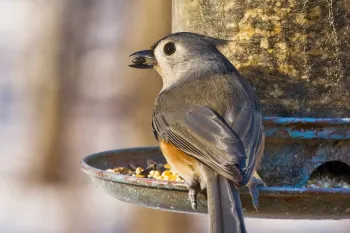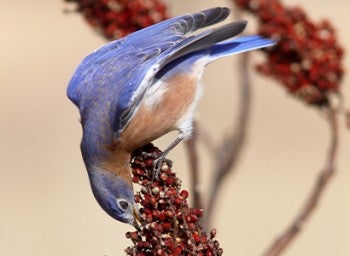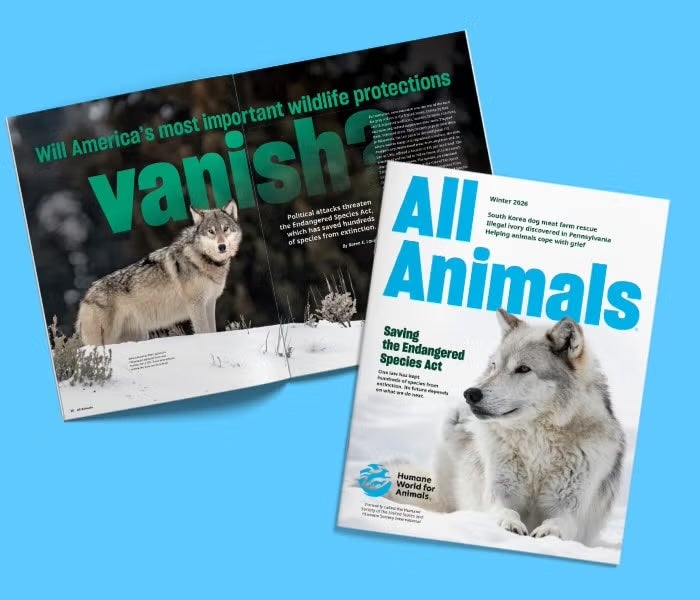Of all the surprising twists and turns my venture into the world of wildlife gardening has taken, the one that stands out most is the day I learned about the dark side of my favorite symbol of hope and summer: the sunflower.
It was in the early 2000s and the fledgling gardens at my new home were just coming into bloom. After years of cultivating smaller potted plants on an apartment balcony, I could hardly wait to see the happy yellow faces of these garden giants burst forth.
Much to my dismay at the time, the sawfly larvae could hardly wait either. An online search to identify the tiny green worm and find a solution led to an unexpected discovery: a white paper describing the killing of native birds to save sunflower seeds grown, in part, for backyard bird feeders. Red-winged blackbirds, grackles and other blackbird species were descending on fields of commercially grown sunflowers just as the seeds were ready for harvest. And the growers and the federal government weren’t happy about it.
Referred to as pests by the National Sunflower Association, blackbirds have been subjected over the past several decades to harassment, shootings, experimental poisoning programs and chemical spraying of their roosting sites. All for the crime of daring to feed themselves.
The more I researched the connection between sunflower crops and blackbird killings, the more I realized that the issue is complicated, extending well beyond bird food. A small percentage of the overall yield ends up in birdseed bags; far more makes its way into sunflower oil and seeds for human consumption. And the problem isn’t limited to sunflowers. When any crop is grown in sweeping monocultures, animals often lose; witness the plight of the monarch butterfly, whose once vast swaths of milkweed habitat along the edges of farmlands have been decimated by weed killer within just a few years.
Of course, not everyone thinks of the animals who dine on nature’s bounty and raise their babies in its welcoming habitats as symbols of economic loss. Some farmers have found ways to accommodate or gently deter the wild creatures visiting their lands. And government and university scientists continue to research nonlethal alternatives, including the growth of “decoy fields” set aside for hungry birds.
Still, lethal wildlife control continues to this day, in spite of ever-growing environmental threats to animals. Blackbird detractors point out that they are among the most common species in North America. But so were the passenger pigeons, who filled the skies by the billions only 50 years before the species was reduced to one lone survivor, Martha, at the Cincinnati Zoo. The 100-year anniversary of her death was solemnly commemorated in September with renewed calls for protection of native birds. As noted in The State of the Birds 2014 report, published by a consortium of public and private entities, “keeping common birds common, while we still can, is as important as preventing extinctions of rare species.” Among those common birds in steep decline, according to the report, are two blackbird species.
JPecha/iStock.com
Make your backyard a safe place for wildlife
No matter how big or small your outdoor space, you can create a haven for local wildlife. By providing basic needs like water, food and shelter, you can make a difference in your own backyard.
The sunflower-blackbird conflict has given me much to think about over the years. As an animal lover and environmentalist, I recognize that my role in the ecosystem and free market will always be fraught with contradiction. As long as I’m eating products with sunflower oil or buying corn and rice and other foods birds love, I can’t deny my contribution to the problem. But just because it’s not possible to live purely doesn’t mean we can’t all do our part to mitigate the damage. In the case of backyard wildlife, I’d rather not contribute to the sad irony of feeding birds foods that may have been grown at the expense of their brethren thousands of miles away.


